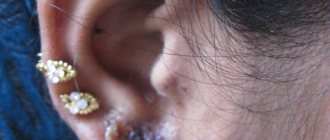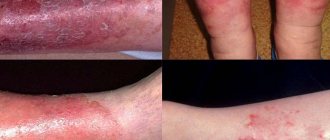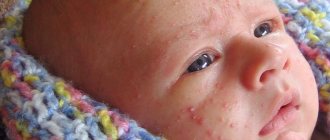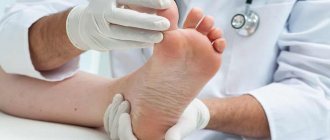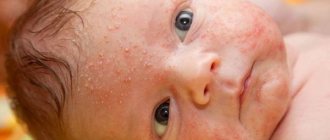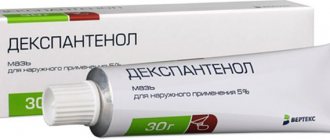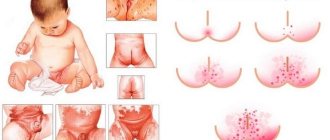Diaper dermatitis, as the name suggests, is diagnosed in babies who do not yet know what a potty and toilet are. The risk of the disease is especially high in girls and boys with sensitive skin.
This disease also occurs in adults who have long since left the “diaper” state, but for various reasons are forced to use diapers.
According to medical statistics, almost 60 percent of infants suffer from this skin disease to one degree or another.
However, the argument “it’s okay, it happens to everyone” is not suitable: if a mother looks at a photo on the Internet of what a tiny sore bottom looks like, on which there is not a single “living place” left, she will make every effort to prevent this from happening to her baby.
Symptoms
Diaper dermatitis (experts also call it “erythema of the buttocks”) according to the ICD-10 classification of diseases has code L22. The symptoms of the disease are clear even to a non-specialist:
- inflammation of the buttocks and genitals;
- redness and peeling;
- in difficult cases – weeping areas, wounds, pimples;
- painful sensations when touched;
- burning, itching;
- general anxious state – tears, whims.
An important point: the skin is inflamed in those places where it comes into contact with diapers and diapers.
If similar signs appear in other places (for example, on the cheeks, behind the ears), there is a high probability that we are not talking about diaper dermatitis, but about some other disease. This means you need to seek help from a doctor.
Medical assistance cannot be avoided even if parents are unable to cope with the problem on their own: neglected diaper dermatitis can turn into chronic or serve as an impetus for some other, more serious skin disease.
In bottle-fed infants, the skin near the anus requires special control, since the stool of such babies has a stronger alkaline reaction, and the discharge dangerously irritates the baby’s delicate skin.
Video with useful tips for parents from the Union of Pediatricians of Russia:
Dermatitis on the butt in children and adults: symptoms, causes and treatment methods
Dermatitis on the butt is an unpleasant phenomenon that anyone can experience, regardless of age. The rashes manifest themselves in different ways, but cause significant discomfort. To treat dermatitis, you need to seek help from a doctor and only then use traditional methods.
- Causes
- Symptoms
- Therapy Drug therapy
- Folk remedies
Causes
Dermatitis on the buttocks has its own reasons for its appearance. In an infant, the rash is most often called diaper dermatitis; in adults, the names atopic and allergic can be used to denote skin irritation .
Factors influencing the appearance of rash and itching:
- heredity,
- malnutrition (vitaminosis, toxins),
- rotting and fogging of the skin in clothes made of rough fabric,
- the occurrence of an allergic reaction to washing powder or synthetic underwear,
- irritation in bedridden patients due to lack of ventilation, diaper rash or insufficient hygiene,
- violation of hygiene procedures,
- sedentary and sedentary lifestyle,
- long-term use of strong hormonal drugs or antibiotics,
- chronic form of diseases of the digestive system,
- being overweight,
- allergic reaction to diapers and poor hygiene in young children.
These factors contribute to the appearance of rashes on the buttocks. In some cases, to eliminate the symptoms, it is enough to eliminate the cause of the problem.
Symptoms
Symptoms depend on the form of dermatitis and the source of the lesion:
- The contact variety is characterized by the appearance of tissue swelling, itching, and pain in case of contact with a factor that causes an allergic reaction.
- The bacterial form appears as small blisters containing pus. It is highly painful.
- Fungal dermatitis appears as a white patch with significant peeling of the upper portion of the skin. The disease develops due to low immunity.
- Atopic - expressed by severe itching, rashes and redness. Doctors consider the symptoms of this form to be similar to those of neurodermatitis.
- Viral is a complication of a past illness. Manifestations depend on the type of infection.
The photo shows clear differences between the atopic form (left) and the disease of a bacterial nature.
It is believed that if the symptoms of gluteal dermatitis do not go away within 3 days, even after excluding possible sources of irritation or an increased level of hygiene in an adult or child, you should consult a dermatologist.
Therapy
Treatment of dermatitis should be started immediately after the first symptoms appear. It is especially important to pay attention to the pathology if the skin lesion is observed in a small child who cannot take care of himself.
The first stages of first aid:
- elimination of irritating factors (underwear, used cosmetics),
- replacing synthetic underwear with cotton,
- choosing loose clothing to reduce contact with affected areas of the skin,
- changing your diet (reducing the amount of spicy, fatty or toxic foods),
- taking antiallergic drugs,
- use of non-hormonal drugs,
- using folk recipes to relieve itching and irritation.
Dermatitis therapy is a set of measures to improve the external and internal condition of the skin . For quick and effective treatment, it is recommended to consult a specialist.
Drug therapy
Often, the elimination of dermatitis symptoms is delayed due to the fact that patients see a doctor too late. Ignoring the problem can lead to irritation spreading to the hip area and beyond.
If the disease affects a small child, then it is necessary to ensure prolonged contact of the skin with air and use ointments.
Usually the doctor prescribes the following drugs:
- To eliminate itching and burning - Tavegil, Claritin, Suprastin. These products are recommended for relieving allergy symptoms in rashes on other areas of the skin.
- In some cases, therapy using hormonal drugs is used. These include Akriderm, Sinaflan, Diprosalik.
- If pain or itching prevents a person from falling asleep, it is recommended to use mild sedatives: Novo-Passit, Persen, Glycine, alcohol tinctures or tablets of motherwort and valerian root. These drugs contain natural ingredients, and their effect is not addictive in patients.
Folk remedies
Traditional medicine offers many recipes to eliminate signs of dermatitis not only in the buttocks, but throughout the body. Their action is based on the use of natural ingredients and a gentle effect on the human body.
- Chamomile flowers. You need to pour 4 tablespoons of dry chamomile into 2 liters of water. The product is heated over low heat for a quarter of an hour. After filtering through cheesecloth, the broth is added to the bath water.
- Oak bark. A tablespoon of crushed bark is poured into a glass of water. The mixture is heated over low heat for 20 minutes. Strain the broth through cheesecloth and add to the bath.
- Leaves of a succession. For a tablespoon of dried plant material you will need a glass of water. Keep the container with the broth on low heat for a quarter of an hour. The filtered medicine is poured into water during water procedures.
- Birch buds. The recipe for preparation and use is similar to the previous one.
- Pumpkin. A tampon soaked in juice or pumpkin pulp must be applied to the affected area of the skin. The procedure is continued for 20 minutes, it is recommended to repeat it 4 times a day. You can alternate every other day with the use of aloe using the same technology.
- Propolis oil. The crushed product is mixed with sunflower oil in a ratio of 1:4, heated in the oven for 45 minutes. Pour into a glass container. Wet a swab and apply it to the affected area of skin 2 times a day.
The described remedies can reduce itching, irritation and reduce the development of the inflammatory process in tissues. However, we should not forget that these methods for severe rashes are effective only as an auxiliary therapy.
If a person experiences symptoms related to a fungal or bacterial infection, traditional recipes may not be enough and self-medication will only delay the moment of recovery. To treat severe manifestations of the disease, you must seek help from a doctor .
Dermatitis in the buttocks is an unpleasant phenomenon from which no one is immune. To treat the disease, sedatives and antiallergic drugs are used, as well as traditional medicine methods. The main goal of therapy is to reduce the manifestations of the disease and improve the general condition of human skin in the affected area.
Assess your chances against coronavirus. Take our test
Attention!
The site administration advises you not to self-medicate, and in any controversial situations, consult a doctor.
Source: https://fr-dc.ru/kozhnye-zabolevaniya/prichiny-poyavleniya-dermatita-na-pope-i-osobennosti-lecheniya
Causes
Babies are easy prey for this disease: their skin is very delicate, their immunity is not strong enough, and their thermoregulation functions are still imperfect.
In addition, many children have an allergy or a predisposition to it, which makes the skin even more vulnerable.
The immediate causes of diaper dermatitis are as follows:
- “greenhouse effect” - high temperature and humidity under the diaper;
- lack of air access to the skin under diapers and nappies;
- rubbing them, as well as clothes, on the body (this happens especially often if parents made a mistake with the size of the diaper or put it on incorrectly);
- the presence of various irritating components in urine and feces (for example, ammonia, salts);
- poorly selected creams and powders that cause inflammation on the baby’s skin;
- infection by pathogenic microorganisms, fungi.
According to experts, hygiene is the most important thing in caring for your baby..
The disease will not be long in coming if parents keep the baby in wet diapers for a long time, rarely change diapers, do not bother washing clothes, but only dry them, and do not regularly organize water treatments for the child.
What does diaper dermatitis look like?
Surely, not every mother knows what exactly the rashes have formed on the child’s skin. Therefore, it is important to determine what this type of dermatitis looks like and what symptoms are most common.
- In the area of the groin folds, on the thighs, buttocks and genitals, redness and abrasions appear, which are considered to be diaper rash. This is the first stage.
- Red spots of different sizes begin to appear on the skin. They occupy large areas and merge with each other. This indicates that the disease has entered an active stage and complications have begun to form.
- Now the newborn can observe peeling of the skin and the formation of crusts on intradermal blisters, the spread of erosion and small wounds.
- Advanced dermatitis is determined by the presence of blisters on the skin filled with cloudy liquid. This also indicates that the wounds have become infected with a fungal infection or staphylococcus.
Dermatitis can also be divided into subtypes, depending on where it appeared and for what reason.
- With frequent regurgitation, the baby develops redness in the folds of the neck, which is caused by irritation of products from the baby's stomach that enter there.
- If the baby's feeding process is disrupted, he may develop perianal dermatitis, expressed by inflammation of the skin around the anus.
- Children may also experience limited damage in the area of the inguinal folds.
- Isolated dermatitis may also appear on the genitals, which develops due to the characteristics of the baby’s urine.
Based on all this, we can conclude that an accurate diagnosis can be made by visual examination. But it will be possible to identify the cause of relapses only with the help of additional diagnostic procedures.
Stages
In a newborn, dermatitis can go through three stages of development.
The first (it is considered the mildest) consists of minor redness from diapers, affecting limited areas of the skin.
The second stage is characterized by abrasions, diaper rash on the butt and groin, and in difficult cases, infection by pathogens.
The third stage is the recovery period. If complications and infection are avoided, and the treatment is chosen correctly, the child recovers quickly, diaper rash is cured within three days.
The main symptoms and treatment of toxicerma are described in this article. Find out more!
You will find a list of emollients for atopic dermatitis in children in this material.
Nutrition for seborrheic dermatitis on the head (diet menu) is discussed here: https://udermatologa.com/zabol/derm/seb/menyu-diety-pri-seboree-kozhi-golovy-i-litsa/
What is diaper dermatitis?
A disease that often worries newborns - diaper dermatitis - occurs when the baby's skin comes into direct contact with diapers or diapers.
It manifests itself in the form of a rash and redness, mainly on the child’s bottom and genitals. The folds of skin on the neck and, worst of all, in the groin area can be affected.
Both girls and boys under the age of 3 who have not yet learned to control urination and bowel movements (are not potty trained) are susceptible to this disease.
How to identify diaper dermatitis in children
Babies aged 4-6 months suffer most often. At this age, they begin to move actively and sweat a lot. This activity causes damage to the skin.
In bedridden patients, the occurrence of diaper dermatitis is not uncommon. In their case, the appearance of redness and rash is associated with a decrease in the body's protective functions.
Skin regeneration processes slow down. As a result, any scratch can cause serious complications.
There are three stages of diaper dermatitis. The easiest one is the first one. At the initial stage, the disease manifests itself in slight redness. They usually appear in places where the baby's skin comes into contact with the diaper.
Diaper dermatitis: photos, symptoms and treatment
The second stage is characterized by: abrasions, diaper rash on the buttocks and in the groin area. In severe cases, infection occurs with fungi - pathogenic microorganisms.
The third stage is the healing process. With proper treatment, it lasts no more than 3 days.
Kinds
There are several types of diaper dermatitis, each of which requires a special approach to treatment.
Bacterial
The bacterial form of the disease is classified as a complication that occurs in a child suffering from diaper dermatitis.
In this case, the baby’s body is attacked by various bacterial infections; the doctor identifies the symptoms of these diseases and selects the most effective treatment.
Candida
Inflammation is concentrated in the groin and perineal area. The color of the affected surfaces is bright red.
This type of dermatitis is weeping, although there are also dry, inflamed, scaly areas.
If you do not start treating the disease in time, its pathogens can penetrate the body, complicating the condition of the little person.
Candidal diaper dermatitis requires specific therapy; doctors prescribe Ketoconazole, Miconazole and others ointments to the patient.
It is impossible to select funds without the participation of a pediatrician, as they may not be effective enough. But even in this case, you can’t count on quick treatment; it can last a month.
Fungal
When, after 3-4 days, treatment of diaper dermatitis remains ineffective, the inflammation does not go away, there is a high probability that the baby has fungal diaper dermatitis.
If such a diagnosis is made, the doctor prescribes antimycotic (antifungal) medications to the small patient. Clotrimazole and nystatin ointment may be recommended.
Warning against self-medication, doctors remind that antibiotics have no effect on yeast fungi.
If in a situation with fungal diaper dermatitis you rely on this type of medication, the disease will begin to progress, the inflammation will intensify, sores and blisters will appear.
Intertrigo
This type of dermatitis is caused by skin rubbing against skin. Light abrasions appear that become inflamed when they come into contact with urine.
This type of disease can be distinguished from others by the characteristic yellowness that covers the inflamed areas of the skin.
Impetigo
With this type of diaper dermatitis, which is considered staphylococcal, the skin on the thighs, buttocks and lower abdomen becomes inflamed.
The disease develops according to two scenarios: with the presence of blisters (bullous form) and without them, but with scars and yellowish crusts.
The disease and its definition
Diaper dermatitis is an inflammatory reaction of the baby's skin to mechanical, physical, chemical and microbial influences. Moreover, all these factors tend to join each other in a certain order. Diaper dermatitis can most often be observed in bottle-fed children and girls. Although, according to statistics, dermatitis occurs in 60-62% of newborn babies.
This disease can last from the moment of birth and up to 3 years, until the child learns to control his trips to the toilet. In general, the peak development of dermatitis occurs between 6 and 12 months.
Separately, it is worth mentioning that the nature of the child’s diet, as well as the characteristics of his skin, are of great importance in the development of dermatitis. That is why we can divide children into those for whom diaper dermatitis is treated easily and quickly, and those for whom it constantly appears again and again, and does not want to leave its “owner” at all.
Diaper dermatitis occurs due to high levels of humidity in the areas where diapers or nappies adhere to the skin. The situation is aggravated by the fact that air access to these places is limited. As a result, children's delicate skin becomes exposed to danger and any irritant (urine or feces) is enough for it to trigger a skin response consisting of inflammation. And if tissue friction is also added to such a tandem, then we can observe a detailed clinical picture of the disease with its most striking manifestations. Over time (from 6 to 36 months), the child’s skin begins to “mature”, and the problem goes away, thanks to the body’s protective mechanisms.
Diagnosis of the disease
To make a diagnosis, a doctor may only need to visually examine the patient and interview the mother. What to do if there is a suspicion of secondary infection? Conduct a more in-depth laboratory examination.
Usually, the pediatrician sends bacteriological culture of materials for examination (they are taken from inflamed areas of the skin), recommends blood and stool tests (for dysbacteriosis).
The data obtained make it possible to identify the causative agent of the disease and select the best means of combating it.
We invite you to read Dr. Komarovsky’s opinion on the methods of treating diaper dermatitis:
How and with what can diaper dermatitis be treated?
Dermatitis, according to Dr. Komarovsky, can be cured fairly quickly. To do this, you just need to identify the cause and begin to competently eliminate the painful problem. So, the main thing in the treatment of diaper dermatitis:
- Steadily keeping inflamed skin areas clean and dry. To do this, it is enough to use diapers with gel content. You just need to remember that the diaper must match the size and age of the baby. Also, the baby should be comfortable in it.
- Even when using regular diapers, parents should change them promptly. After each diaper change, the baby’s skin needs to be treated (wash the baby, wipe with wet wipes, etc.).
- Every evening you can wash your child with a decoction of string, chamomile or oak.
- After the diaper is removed, the child must not only be treated, but also his skin must be left to “breathe” a little.
- It is necessary to choose the right diaper products. It can be powder, ointment or cream.
- If the baby has been diagnosed with a fungal infection, the doctor will prescribe ointments such as miconazole or clotrimazole.
- Dress your child correctly. His clothes should be comfortable and made from natural materials. Don't wrap your baby up, but don't let him freeze either.
- If your child begins to have suppuration at the site of the rash, then antibacterial ointment will help you. Newborn babies can be smeared with tetracycline eye ointment, which does not cause a burning sensation or discomfort.
If you see the first signs of diaper dermatitis in your child, then immediately begin to eliminate the problem. Komarovsky and other pediatricians today say with confidence that the most important thing in the treatment of dermatitis in children is time. The sooner you sound the alarm, the easier and faster the fight against this disease will be.
Treatment of diaper dermatitis in children
First, a few general recommendations:
- if the dermatitis is weeping, drying ointments or powder will help;
- if wounds and cracks have formed at the site of redness, you need an ointment that accelerates the regeneration of the skin;
- To treat the inflamed surface, you cannot use both powder and cream at the same time;
- hormonal ointments cannot be used against diaper dermatitis (for example, such an effective remedy as Advantan is one of them);
- Regular air baths (they are strongly recommended by the famous pediatrician Komarovsky) lasting 10-15 minutes help very well.
Help of drugs
It is impossible to quickly cure diaper dermatitis without the use of medications - ointments, lotions, creams.
Before using them, a little preparatory work is carried out: they wipe the inflamed areas with a swab dipped in a healing decoction of chamomile, string, or some other medicinal plant, and then, to dry the skin, they organize an air bath for the baby.
Methods of treatment and prevention of the process
An important part of treating diaper dermatitis in children is proper skin care. It is necessary to stop exposure to the irritating factor. You cannot use waterproof diapers. When using disposable diapers, you should not forget about the need to change them regularly. Urine and feces must be washed off in a timely manner; the child should not stay in dirty diapers or onesies for a long time. Overheating of the body contributes to the appearance of symptoms of dermatitis, so the child should be dressed according to the weather. Compliance with all the above recommendations will help cure the disease as soon as possible. Further therapeutic measures will be selected by the attending physician. In the presence of weeping ulcers, anti-inflammatory and healing ointments are used. If the skin is excessively dry, emollients and moisturizers are applied to the affected areas.
Dermatitis can be cured using topical medications.
The set of measures taken to treat dermatitis and the method of preventing diaper rash in infants can be called almost the same. First of all, so that your child does not suffer from such an unpleasant skin disease as newborn dermatitis, mothers need to strictly follow all the rules for caring for the baby. It's quite simple:
- A soiled diaper should be changed no later than 4–5 hours. But it is possible more often, especially immediately after the birth of a child, when acts of defecation occur almost constantly, especially after receiving milk, which is carried out up to six times a day, or even more.
- Removing and changing diapers should be accompanied by hygienic procedures - washing the baby with warm water, in the first 15-20 days the use of soap is mandatory, then you can do without it. This is due to the fact that soap disrupts the functions of the protective mechanisms of the skin and contributes to the appearance of persistent, long-term diaper rash.
- The use of delicate natural towels and food napkins has proven to be excellent for wiping and blotting.
- It is mandatory to apply a special protective cream to the skin in the perineum and all surrounding folds. Experts consider the best creams to be dense, thick baby products that adhere well to the surface of the skin. Iodine for cauterization is strictly contraindicated; it only potentiates the process. Liquid oils also show a high effect of the procedure, as well as lanolin and Bepanthen.
Only after weighing all the nuances is the medication prescribed
How to treat a child with uncomplicated dermatitis? The use of antihistamines in such cases is inappropriate. If the course of the disease is not combined with bacterial infections, treatment will be carried out according to the following scheme: wash - wipe - ventilate. Dermatitis can be cured using external preparations based on zinc oxide - Bepanten, Panthenol, Drapolene. They moisturize the skin, accelerate healing processes, and prevent the development of infection. Wet areas are dried with powder. For candidiasis forms of the disease, antifungal ointments and solutions are used. They are applied 3 times a day, the course of treatment lasts at least 30 days. Hormonal drugs are not used in the treatment of diaper dermatitis; they can aggravate the course of the disease. Traditional recipes can only be used to treat mild forms of the disease. When bathing, add decoctions of medicinal plants - chamomile, oak bark, string - to the bath. 2 tbsp. the herbs are poured into a glass of boiling water, infused for an hour and added to the bath.
Diaper dermatitis is treated with special ointments and creams that contain zinc oxide. These drugs have a double effect: they destroy bacteria on the affected areas of the skin and at the same time form a barrier to the entry of mucus and other secretions into the skin.
You cannot use any ointment for diaper dermatitis before consulting a specialist, since the product can cause allergic reactions, which will further aggravate the situation, and treating complications is much more difficult than the disease itself. Only the attending physician decides how to treat diaper rash, and before that you can use baths of medicinal herbs: string, calendula or chamomile. It is not recommended to use all herbs at the same time for dermatitis, since it is unknown how the skin will react to such a combination. And the child should be washed after each bowel movement, the skin after hygiene procedures should only be blotted with a soft towel, and only loose swaddling should be used.
You should not use any ointment before consulting a specialist.
Before consulting a doctor, it is not recommended to use cauterizing drugs: potassium permanganate, methylene blue, iodine, etc. They dry the skin and can cause additional cracks to appear. But iodine is included in the composition of such a cream for diaper dermatitis as Povidone, in the form of a constituent substance Povidone iodized. The product has recently proven itself well as a drug that can not only quickly cure various types of dermatitis, acute and chronic bacterial skin infections, but also cope with such a complication as candidiasis infection. Povidone has a composition that makes it possible to use it in the treatment of children.
When using Povidone ointment, atomic iodine and iodide ions are slowly released, which, when interacting with bacterial proteins, form iodamines, blocking their reproduction. Therefore, it is enough to use Povidone 1-2 times a day, not more often. Atomic iodine retains its antibacterial properties even after contact with water with the necessary hygiene procedures. The effect of using Povidone-iodine continues until all active iodine is released, which is 10–12 hours. This explains the great popularity of the drug, especially among young parents. But the ointment should not be used for longer than 2 weeks, including for the treatment of adults. The drug is also prescribed to allergy sufferers with caution.
Treatment may take several weeks
The use of herbal preparations, herbal decoctions, aloe or Kalanchoe juice is irrelevant. Doctors say the risk of allergic reactions is too high. Usually the doctor can prescribe complex medications. This is the use of zinc ointment, tithe, sudocrem and their analogues, known to all pediatricians. Traditionally, the pediatrician studies all the indications for the use of a particular drug, as well as a set of contraindications and possible complications. Only after weighing all the nuances is the medication prescribed.
How to treat skin irritation from diapers in adults
Skin irritations are not uncommon in bedridden patients. They cope with them using both traditional methods, using decoctions of medicinal herbs, and medications.
For diaper dermatitis, ointments with lanolin and zinc oxide are used. Levomekol ointment, for example, is effective against bedsores, prickly heat, and diaper rash.
If you need to get rid of fungal infections, you can use Miconazole, Batrafen. Baneocin is effective in the fight against pathogenic flora.
Air baths are useful: you need to remove the patient's diaper and underwear, under which there are inflammations on the skin, and give the person the opportunity to lie down without them for a while.
And, of course, regular patient care and compliance with hygiene requirements are important.
The causes, symptoms and treatment of atopic dermatitis in children with folk remedies are presented in our publication.
The composition of the cream with hyaluronic acid Skin-Active, reviews of its use, as well as analogues can be found in the following material.
Causes of development of diaper dermatitis
There are many reasons for problems. The most common ones are the following:
- Exposure to urine. A moist, warm environment in a diaper disrupts the protective function of the skin. In addition, urine changes its chemical composition over time, which irritates the skin.
- Chair. Stool contains bacteria that disrupt the healthy skin barrier.
- Mechanical damage to the skin from a diaper. The friction areas of the diaper can damage the skin, making it easier for infection to develop.
- Bacterial and fungal infections that can easily penetrate the dermis.
- Irritation of children's skin caused by chemicals from wet wipes, soaps, washing powders, fabric softeners.
- Diaper dermatitis is more common with diarrhea, the use of antibiotics, and dietary changes, for example, at the beginning of complementary feeding.
Prevention of diaper dermatitis
Preventative measures begin literally with the purchase of a diaper. It is very important to choose the right size; for this you need to know the patient’s weight - only in this case the pharmacy will offer you exactly the product you need. If the diaper is too tight, it will definitely rub the skin.
Pay attention to the quality of this product: it is desirable that the diapers have an absorbent layer , which not only quickly absorbs liquid, but also turns it into a gel.
Other preventive measures include:
- taking care of clean and dry skin;
- frequent changes of diapers (they should only be worn on dry skin);
- treating the skin after defecation with special lotions, oils and creams;
- using linen made from natural rather than synthetic fibers;
- washing with high-quality, hypoallergenic powders;
- regular air baths.
If such preventive measures seem unnecessary to someone, remember the advice that doctors never tire of repeating: it is better to spend time and effort on prevention than to fight (difficultly, not always successfully) directly with the disease.
Dermatitis in a newborn
An important therapeutic and preventive factor is staying in the fresh air. This can be an air bath at home, after taking hygiene procedures, but a special effect can be obtained from staying in the air on hot days when ultraviolet radiation is added. Mothers should pay attention to the use of disposable or reusable diapers in this situation; swaddling with them is perfect for everyone. This could be a newborn or an infant up to one year old. If there is no allergy to natural fibers, babies can be laid out in the air on sheepskin, which very carefully envelops the newborn and protects his skin from diaper rash. Promoting natural nutrition for as long as possible will help to avoid the appearance of diaper dermatitis or reduce its activity. Since ancient times, mother's milk has rightfully been called the best medicine for the most severe internal and external pathologies.
Reviews
Rita G.: “My daughter’s skin turned very red in the groin - it was due to an allergy, to baby food, then to diapers (did you buy them and is there an allergy to them). In general, for a long time they could not understand what it was. And the young doctor kept experimenting - one remedy, another... One day we had an appointment with another pediatrician, she recommended Baneocin. We finally breathed a sigh of relief: it helped.”
Nadezhda S.: “My mother advised me to treat my daughter’s diaper dermatitis by treating the redness with brilliant green. I tell her: this is not a modern drug; many more effective ones have now been invented. I went online, to a forum where these problems were discussed, and became convinced that I was right - brilliant green heals damage to the skin more slowly, and in addition to this, it kills all the natural protective substances present on it.”
Irina Y.: “My son had diaper dermatitis, a friend recommended folk remedies to me. I was happy, it wasn’t chemistry after all. It turned out that the baby was allergic to the oak bark with which I started preparing baths. I advise everyone to be careful with folk remedies - do not use them without checking and without consulting a pediatrician!”
Treatment
The attending physician will tell parents how to treat diaper dermatitis. Treatment can be either therapeutic or medicinal.
Therapeutic treatment can be carried out using medications and folk remedies. Mandatory rules that cannot be violated are:
- personal hygiene;
- elimination of the inflammatory process with ointments and creams.
Drug therapy is carried out as follows:
- Removing the diaper. Rinse the affected area with clean warm running water - buttocks, groin.
- Restriction and, if possible, complete exclusion of the use of various hygiene products. It is best to use clean water or hypoallergenic products during this period.
- Be sure to blot moisture. It is forbidden to make rubbing movements with a towel.
- Air dry your baby's skin - leave him to dry.
- The affected areas of the skin can be lubricated with a remedy for diaper dermatitis - Lanolin, Desitin, Sudocrem, Bepanten gels and ointments.
- If a fungal infection is present, medications may be prescribed.
If diaper dermatitis is detected in a child, it is imperative to seek qualified help from a therapist. If necessary, he can refer the child for a consultation with a dermatologist.

